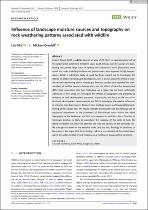| dc.contributor.author | Mol, Lisa | |
| dc.contributor.author | Grenfell, Michael | |
| dc.date.accessioned | 2023-06-05T09:23:38Z | |
| dc.date.available | 2023-06-05T09:23:38Z | |
| dc.date.issued | 2022 | |
| dc.identifier.citation | Mol, L., & Grenfell, M. (2022). Influence of landscape moisture sources and topography on rock weathering patterns associated with wildfire. Earth Surface Processes and Landforms, 47(7),1761–1777. https://doi.org/10.1002/esp.5345 | en_US |
| dc.identifier.issn | 1096-9837 | |
| dc.identifier.uri | https://doi.org/10.1002/esp.5345 | |
| dc.identifier.uri | http://hdl.handle.net/10566/9009 | |
| dc.description.abstract | From 9 March 2015, a wildfire burned an area of 25.7 km2, or approximately half of
the Jonkershoek catchment (Western Cape, South Africa), over the course of 3 days.
During this period, large areas of fynbos and commercial forest plantations were
razed, and rocks, including boulders and smaller rocks, were exposed to high temperatures.
While a substantial body of work has been carried out to investigate the
effects of wildfire on landscape development, less is known about the effect of wildfire
on rock weathering within a landscape. Previous studies have reported the overall
effect of wildfire on rock deterioration, but the effect of intra-fire temperature
differences associated with heat behaviour on a slope has not been sufficiently
addressed. In this study we investigate the effects of topography and proximity to
moisture on rock deterioration processes. | en_US |
| dc.language.iso | en | en_US |
| dc.publisher | Wiley | en_US |
| dc.subject | Climate change | en_US |
| dc.subject | Topography | en_US |
| dc.subject | Wildfire | en_US |
| dc.subject | Geography | en_US |
| dc.subject | Geoscience | en_US |
| dc.title | Influence of landscape moisture sources and topography on rock weathering patterns associated with wildfire | en_US |
| dc.type | Article | en_US |

